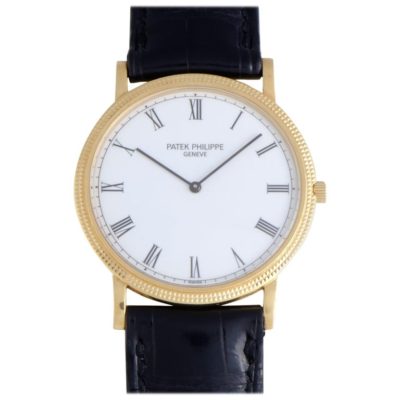A walk through the Forum shops at Caesars Palace in Las Vegas brings one dominant message. This is the Mecca of Luxury Branding. For jewelry and “signature” watches, it’s Bulgari, Chopard, and Tourneau. For clothing it’s Armani, Bernini, and Escada. And don’t forget the three V’s— Versace, Valentino, and Vasari.
My fantasy watch
Walking by one shop, a familiar watch catches my eye. It’s a Patek Philippe, the understated, simple Calatrava model that I have coveted since learning about them more than thirty years ago. They are still hand built, still mechanical, and still stunningly accurate—even when passed to a second generation. Today, it can be mine for about $13,000, due to a recent 20 percent price increase.
I blink in amazement. That’s more than double the price I remembered.
Back in Dallas, I visit deBoulle, the high end Highland Park jewelry store. Owner Denis J. Boulle confirms the price. It’s $13,850. This is a Trophy watch, a watch distinguished by its quality and relative rarity.
A long history of rarity
History shows that the Patek Philippes made in very small numbers have enjoyed astounding appreciation. Indeed, 80 of the 100 most expensive watches ever sold in auction sales have been Patek Philippes. From the early 80’s to now, for instance, prices have multiplied about 60 times.
Yes, you read that right. Sixty times. That’s an annualized increase of about 22 percent.
Call it Trophy Inflation.
While different trophies have risen in price at different rates, one thing is certain. They had risen much faster than the conventional Consumer Price Index. Whatever the monthly ups and downs of food and energy, whatever the constant increases in medical care costs, the broad increase in consumer prices was only 3 percent a year over the same 20 year period.
Needless to say, the Bureau of Labor Statistics doesn’t track Trophy Inflation.
Tracking Trophy Inflation
But it isn’t difficult to find in the usual places. Start with art auctions. Prices continue to reach new highs and appreciation rates dwarf what most investors have found in the stock market.
A recent listing of the top 100 American auction prices on www.askart.com showed a top price of $27 million (for a George Wesley Bellows). The lowest price in the top 100 was a bit under $4 million. The list includes works by relatively recent artists such as Frank Stella, Jasper Johns, Jackson Pollock, and Roy Lichtenstein. Whatever the current price, we’re looking at gigantic multiples from original sale prices.
Trophy Homes
Nor is Trophy Inflation limited to mechanical or artistic works of art. Consider Trophy houses. Check the Friday real estate listings in the Weekend section of the Wall Street Journal. The Sunday San Francisco Chronicle real estate listings will serve equally well.
And there are always those nifty listings at the end of the New York Times Sunday magazine. Multi-million dollar homes, once rare, are now amazingly common. Many are offered for sums that would have purchased an entire NASDAQ company only 20 or 30 years ago.
Whatever the Trophy object— art, jewelry, watches, houses, cars, or yachts—its price has risen much faster than anything in the world of common objects and everyday living.
And that may include common stocks.
Quality— real quality— may always be our best investment.
Sources/Notes:
I was there recently, but here is a website listing: http://www.reviewjournal.com/shopping/forumshop.html#jewelry http://www.patekphilippe.com/ A picture of the 3919 model can be seen at this url: http://store.yahoo.com/allbrandnamewatches/patekphilippe.html The figure came from a sales person at the store. http://www.deBoulle.com
Art auction prices: http://www.askart.com/interest/TopAuction.asp
In the late 70’s and early 80’s it was not uncommon for NASDAQ listed companies to have total market capitalizations of less than $10 million.
This information is distributed for education purposes, and it is not to be construed as an offer, solicitation, recommendation, or endorsement of any particular security, product, or service.
Photo:
Published in Private Clubs, October/November 2004
(c) A. M. Universal, 2004
